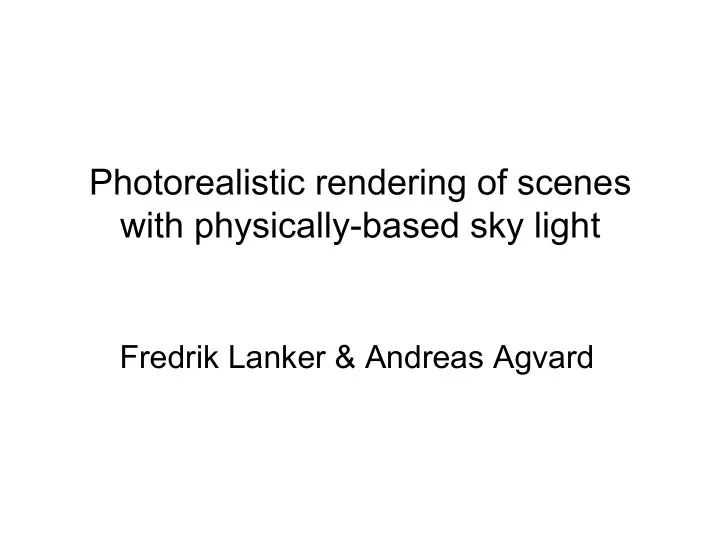

Photorealistic rendering of scenes with physically-based sky light Fredrik Lanker & Andreas Agvard
Background • Realistic computer graphics • Movies • Games • Laws of physics • Models and numerical solutions
Objectives • Be able to calculate the correct position of the Sun, the Moon and the stars in the sky. • Be able to compute and, in real time, visualize an approximative sky given a time and position on Earth. • Be able to render a physically correct sky with both single and multiple scattering and to present this as a light probe that can be used to simulate a sky in a 3d scene. • Be able to render a simple scene using our light probe. • Be able to postprocess the rendered scene to simulate the human vision, e.g. tone mapping and glare effects. • If time allows, be able to simulate clouds and use them in our system.
Why HDR? Image from the CAVE (Columbia Automated Vision Environment) Lab
Multiple exposures + + + + + = Images from the CAVE (Columbia Automated Vision Environment) Lab
Why HDR? Image from the CAVE (Columbia Automated Vision Environment) Lab
Light probes
Light probes From Debevec and Lemmon, SIGGRAPH 2001 Course #14 - Image-Based Lighting
Our model • Two parts — a real-time version and a light probe renderer • Stand alone application not a module or a part of a renderer
Position computations • Calculate positions in ecliptic coordinates (longitude, latitude), independent of viewer’s position • Convert from ecliptic coordinates to equatorial coordinates (right ascension, declination), still independent of viewer’s position • Convert from equatorial coordinates to horizontal coordinates (altitude, azimuth), depends of viewer’s position
Real-time version
Real-time version
Light probe rendering
Light scattering Rayleigh Mie
Ray marching • L n (x, w) = L segment + e -σ t (x)Δx L n+1 (x+wΔx, w)
Ray marching cont. • Single scattering L segment = L sun (x,w’)p(x,w,w’)σ s (x) Δx • Multiple scattering L segment = L sun (x,w’)p(x,w,w’)σ s (x) Δx + ΣL mult
Glare – scotopic PSF
Tone mapping • Simple tone mappers such as linear and logarithmic, suffers from clamping artifacts • We use exposure tone mapping,1 - e -color*exposure • More advanced methods were tested, Reinhard, Ashikhmin
Clouds
Objectives • Be able to calculate the correct position of the various objects in the sky. • Be able to compute and, in real time, visualize an approximative sky given a time and position on Earth. • Be able to render a physically correct sky with both single and multiple scattering and to present this as a light probe that can be used to simulate a sky in a 3d scene. • Be able to render a simple scene using our light probe. • Be able to postprocess the rendered scene to simulate the human vision, e.g. tone mapping and glare effects. • If time allows, be able to simulate clouds and use them in our system.
Recommend
More recommend